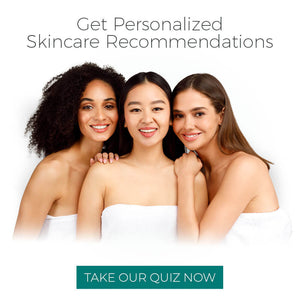Raise your hand if you’ve ever felt like a victim to a stubborn cluster of pimples right in the middle of your forehead. Perhaps you’ve tried everything from home remedies to different treatments to get that smooth skin. Still, nothing seems to work.
Forehead acne can appear for various reasons, and their exact causes vary from person to person. Most people have terrible acne breakouts when they enter their teenage years. These breakouts can affect the entire face.
In this guide, we offer you some science-backed tips and tricks for clearing your skin.
What Does Acne on Your Forehead Mean?
Want to know what does forehead acne mean? The forehead, like the rest of the face, has sebaceous glands that produce oil or sebum. Sebum is a sticky substance that keeps our skin moisturized. However, overproduction of this oil can clog pores especially when it comes into contact with dead skin cells.
Studies show that increased sebum production is the main reason for acne breakouts. On the other hand, genes are a contributor to these breakouts. If you are struggling with acne on forehead, it could mean that you are overproducing oil which makes your skin prone to breakouts. [1]
What Age Is Acne the Worst?
Acne usually starts at puberty - the stage when the body begins to produce sex hormones. During this time, acne breakouts become common among teenagers and young adults. However, acne becomes less prevalent as they get older.
At the age of 12, the prevalence of acne in boys goes up from 40% to 95% until they reach the age of 16. The prevalence among girls ranges from 61% to 83%. This means that almost all boys will have acne before they turn 16. Further, teenage boys tend to have severe acne conditions. Upon reaching adulthood, however, acne becomes more common among women than men. [2]
Types of Forehead Acne
Contrary to what many people think, acne doesn’t affect everyone the same way. Below are the various forms of forehead acne. [3]
1. Comedonal acne
Comedonal acne is characterized mostly by comedones. This type of acne is commonly found on the chin and forehead. It appears when excessive sebum gets mixed with skin debris.
2. Inflammatory acne
Inflammatory acne is a type that causes painful, red, and swollen bumps on the skin. These bumps are filled with too much oil, dead skin cells, bacteria, and pus.
3. Nodular and cystic acne
Cystic acne is quite like nodular acne. The main difference is in the way they feel. Nodules are harder and extremely painful, and they feel like knots beneath the skin. On the other hand, cystic acne is much softer. Some individuals may have both nodular and cystic acne.
4. Whiteheads
Whiteheads are acne that remains beneath the skin's surface and forms a white raised bump.
5. Blackheads
Blackheads are open bumps filled with too much oil and dead skin. These dark spots are often formed when follicles get clogged. Categorically, blackheads are not the same as pimples.
Whiteheads vs. Blackheads: What's the Difference?
Blackheads and whiteheads are a type of non-inflammatory acne - meaning they are not infected and don’t cause pain. The color difference is attributed to how they are formed. Whiteheads are formed in closed pores while blackheads form in open pores. [4]
Blackheads are formed when the pigmentation (melanin) in dead skin cells is exposed to air and reacts with oxygen. When this occurs, the brown pigment of dead skin cells turns to black giving it a dirt-like appearance.
Whitehead, on the other hand, has the same mixture of natural oil and dead skin. It remains white because it stays within a closed pore and hasn't had contact with air. Sometimes, whiteheads appear yellowish. [5]
What Causes Forehead Acne?
What causes forehead acne may often have to do with a range of factors. Hormonal changes, bacteria, humidity, and exposure to harsh chemicals are some leading elements that may cause this acne. The list below presents other potential causes.
1. Hair products
The oil in your shampoos may find its way into your skin while washing your hair. When this occurs, the oil may block your pores which can then cause forehead acne. [6]
2. Tight clothing
Hats, wigs, or other fabrics that you may put on your head can create a warm and tight environment. Sweat, heat, and moisture may create a perfect breeding ground for bacteria. This can lead to acne forming on your forehead.
3. Sweat
The sweat in the skin captures dirt, oil, and bacteria. This debris build-up causes irritation and results in acne on forehead.
4. Makeup
Cosmetics can induce acne and they appear when makeup products block the pores. These products further irritate the skin and worsen acne conditions. Applying heavy and thick makeup foundations or using powders with fragrances can cause further irritation.
5. Excess oil production from skin and hair
Overproduction of sebum leads to excess oil on the hair and skin. This can cause acne.
6. Dead skin cells
Dead skin cells stay stuck inside the hair follicle and on the surface of your skin. This can form a clog or a blockage.
7. Hygiene
Using coarse scrubs, improper make-up removal, using unhygienic make-up applicators, and frequently touching the face with dirty hands can lead to more breakouts.
8. Medication
Some drugs, such as anticonvulsants, corticosteroids, and DHEA, that are packed with iodides or bromides could trigger acne. [7]
9. Hormonal changes
An increase in androgen levels can set off a chain of events. The skin produces more oil allowing bacteria to invade hair follicles. This may cause inflammation.
What Other Conditions Cause Forehead Breakouts?
Other factors can lead to forehead acne. These include: [8]
-
Ringworm is a rash caused by fungi.
- Boils are tender, red, and painful protrusions that develop from infected hair follicles.
-
Folliculitis is a skin problem that happens when the hair follicles become infected or inflamed.
-
Rosacea is a skin condition that results in facial redness and pimples.
-
Contact dermatitis is a skin response to substances you come into contact with, like detergents or fabrics.
-
Cellulitis is a skin infection that emerges around a wound or abrasion.
Tips for Preventing Forehead Acne
“How can I clear my forehead acne?” This is a common question among those with breakouts. With suitable products and mindful lifestyle choices, you can get the results you need. Here are some tips and tricks for you to try.
-
Consistent cleansing: Don’t let your skin become too greasy. Wash your face twice a day. Opt for a gentle, acne-friendly cleanser, like the Rejuvoderm Clarifying Cleanser. These products are specifically formulated for acne-prone skin to combat excess oil production and bacteria.
-
Moisturize regularly: Even if you have oily skin, you still need to hydrate. Use a lightweight, non-comedogenic moisturizer like the Infusoderm Deep Hydration Daily Moisturizer. It can help maintain good skin health and prevent the skin from producing too much oil.
-
Hands off: Your unsanitized hands can transfer oils, dirt, and bacteria to your forehead. Avoiding touching your face is a simple habit that can go a long way in preventing breakouts.
-
Stay hydrated: Drinking enough water helps flush out toxins. It also keeps your skin well-hydrated, which could curb the acne.
-
Use sun protection: Excessive sun exposure can worsen acne and cause skin damage. If you are out in the sun, use sunscreen like Dermaxsol Hydrating Spf Daily Moisturizer to protect your skin without clogging pores.
-
Exercise daily: Physical activity helps regulate hormones and improves blood flow, both of which contribute to healthier skin. Make sure to shower after exercise to remove sweat and prevent clogged pores.
-
Be careful with the skincare products: Choose products that are labeled as non-comedogenic and suitable for acne-prone skin. This ensures that you're not using anything that could potentially clog your pores or exacerbate acne. You can use the product like Zeroblem – Blemish treatment serum to fight against the tough acne
How Is Forehead Acne Treated?
It depends on how severe your forehead acne is. For example, your dermatologist might suggest you use one or multiple treatments.
Usually, the go-to medications are those that you smear directly onto the surface of your skin. Examples of these are topical antibiotics, dapsone, vitamin A, or azelaic acid.
Complex treatments involve oral medications such as isotretinoin, contraceptive pills, or tetracycline medicines. Other options include laser procedures, chemical peels, and steroids. Consult with a dermatologist to get a treatment that works for you. [9]
FAQ
Can stress cause forehead acne?
While stress itself doesn't directly lead to acne, it can throw your hormone levels off balance.
What hormones cause forehead acne?
Androgens are the main hormones that can trigger breakouts on your forehead.
Is forehead acne hormonal?
Yes, most of the time, the acne on your forehead is hormonal. But, it doesn’t have to be.
Is forehead acne serious?
No. This acne is not a serious problem, but it can affect your self-esteem.
Can I remove forehead acne overnight?
No. Unfortunately, it takes time and effort to treat the problem. Consistency is the key.
What is the most common acne on the forehead?
Papules and pustules are recorded as the most common problems on this part of the face.
Conclusion
Forehead acne can definitely get on your nerves. However, it’s important to remember that this is common to almost everyone, which means you are not alone. Check with your dermatologist to understand the underlying causes and find a treatment that works for you.
References
1] ↑https://www.ncbi.nlm.nih.gov/pmc/articles/PMC2835908/
2] ↑https://www.ncbi.nlm.nih.gov/pmc/articles/PMC8510514/
3] ↑https://www.webmd.com/skin-problems-and-treatments/acne/ss/slideshow-acne-dictionary
4] ↑https://www.epiphanydermatology.com/medical-dermatology/whiteheads-vs-blackheads/
5] ↑https://www.ncbi.nlm.nih.gov/books/NBK279211/
6] ↑https://www.aad.org/public/diseases/acne/causes/hair-products
7] ↑https://www.webmd.com/skin-problems-and-treatments/acne/features/medications
8] ↑https://www.healthline.com/health/forehead-acne#associated-conditions
9] ↑https://teamdermatologymd.com/what-causes-forehead-acne-and-crucial-things-to-know/
Mentioned in this article
More stories

Hyaluronic Acid vs Niacinamide: Benefits, Differences







